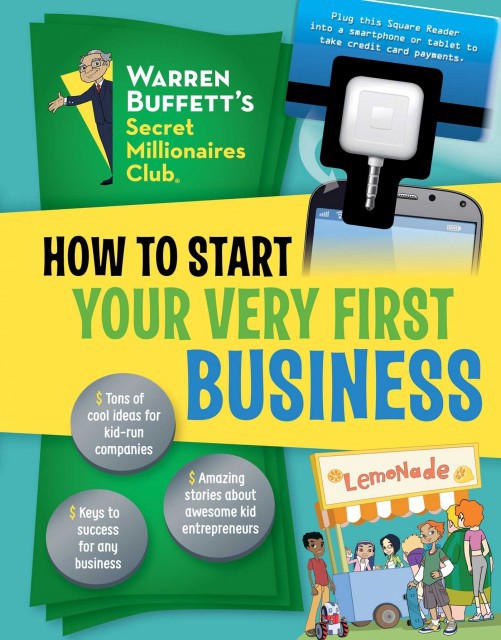Billfold Book Review: ‘How to Start Your Very First Business’

Still looking for that last-minute holiday gift for a child aged 9–12? I recently received a review copy of How to Start Your Very First Business, the newest book in the Warren Buffett’s Secret Millionaires Club series.
I don’t know about you, but I loved reading Zillions Magazine as a kid (as did other Billfolders), and I probably would have been excited about the idea of joining a Secret Millionaires Club. In addition to the books, there is also a Secret Millionaires Club website, which includes comics, games, and a webseries:
But will How to Start Your Very First Business actually teach children how to be Secret Millionaires? (And if you were a parent, would you want your child’s millionaire status to be kept secret from you?)
Here’s what I liked about the book:
— Nearly every page has one or more sidebars that that describe real businesses created by real kids.
— Buffett’s team is serious about what they do. Kids learn real business terms like “markup” and “break even,” they learn about cost-per-unit and profit-per-unit, and in one chapter they are asked to create a business plan.
— The entire book is structured around making money. Running a business might be fun, and Buffett’s team implies that it should be fun a lot of the time, but they put much more emphasis on turning a profit. They even include an example of a kid-run business that is making a profit, but since the profit-per-working-hour is less than what the kid would earn babysitting, the kid is either going to have to grow the business or set it aside.
— There’s a whole section on growing the business. Launching a profitable business isn’t good enough. What are you going to do next month to earn more money? What about next year?
— There are also sections on branding and publicity, because Secret Millionaires who start serious businesses need to know how to send press releases and manage their social media accounts.
— Unlike, say, the opening chapters of Rich Dad Poor Dad, Buffett’s team never suggests that the real way to run a business is to profit off other kids’ labor.
— There’s an entire chapter about philanthropy and giving back to the community. I found that absolutely heartwarming.
Here’s what I didn’t like about the book:
— Those sidebars, with those kid-founded businesses? They’re kids like Moziah Bridges of Mo’s Bows (as seen on Shark Tank!) and Tavi Gevinson. Even the businesses that seem child-sized turn out to be bigger when you look them up online; the 15-year-old girl who interviews nannies, for example, is actually the founder of Nannies By Noa and has been profiled in numerous publications including NYMag:
She has 190 clients in the tri-state area. She has trouble leaving the office at the office: “It’s hard to step away,” she said about taking a family vacation.
Obviously there’s nothing wrong with encouraging kids to dream big. But I doubt that every parent who gives their child How to Start Your Very First Business really wants their child to land 190 clients in the tri-state area. Which means… well, it feels like being in high school and getting handed a French textbook and realizing that none of the teachers actually expect me to learn French, beyond a few words like “markup” and “break even.” It’s disingenuous, and kids pick up on that really quickly.
— Buffett’s team acknowledges that businesses need a lot of resources starting out. Even the humble bake sale needs flour, sugar, two eggs, and access to a kitchen. The book suggests that kids borrow what they need from their parents until they have enough money to pay them back, and includes one example of a kid asking his parents for an $8,000 loan so he could buy a “commercial-grade lawnmower.” As Ester reminded us earlier this month, not all parents have those kinds of resources.
— The book comes with a Square Reader so kids can begin processing credit-card payments right away. I’m curious, and maybe one of you can answer this question: can kids process credit-card payments? Square’s website says “You must be over 18 in order to create an account with Square,” which implies that they can’t. Is the parent supposed to create the account and then teach the kid how to log in with the parent’s account on the kid’s iPhone?
— The book says absolutely nothing about taxes. As a person who has in fact run a small business and has sold merchandise (with a Square Reader!) this infuriates me. Kids have to pay taxes, and they might have to pay sales tax too, and taxes should absolutely be included in any discussion of markup and profit-per-unit.
— The book also doesn’t say anything about business licenses, or permits, or any of the bureaucratic stuff that kids need to figure out before the cops show up to shut down their illegal lemonade stand.
So. Should you get this book for your kid, or for a 9-to-12-year-old you know and love? Sure, why not? But if you’re serious about helping this child start a profitable business, be prepared to offer real resources and real support. Nothing will turn kids off entrepreneurship faster than trying to start a business and realizing that nobody around them is actually invested in their success.
Also, teach the kid about taxes and permits. Because someone has to.
Support The Billfold
The Billfold continues to exist thanks to support from our readers. Help us continue to do our work by making a monthly pledge on Patreon or a one-time-only contribution through PayPal.
Comments